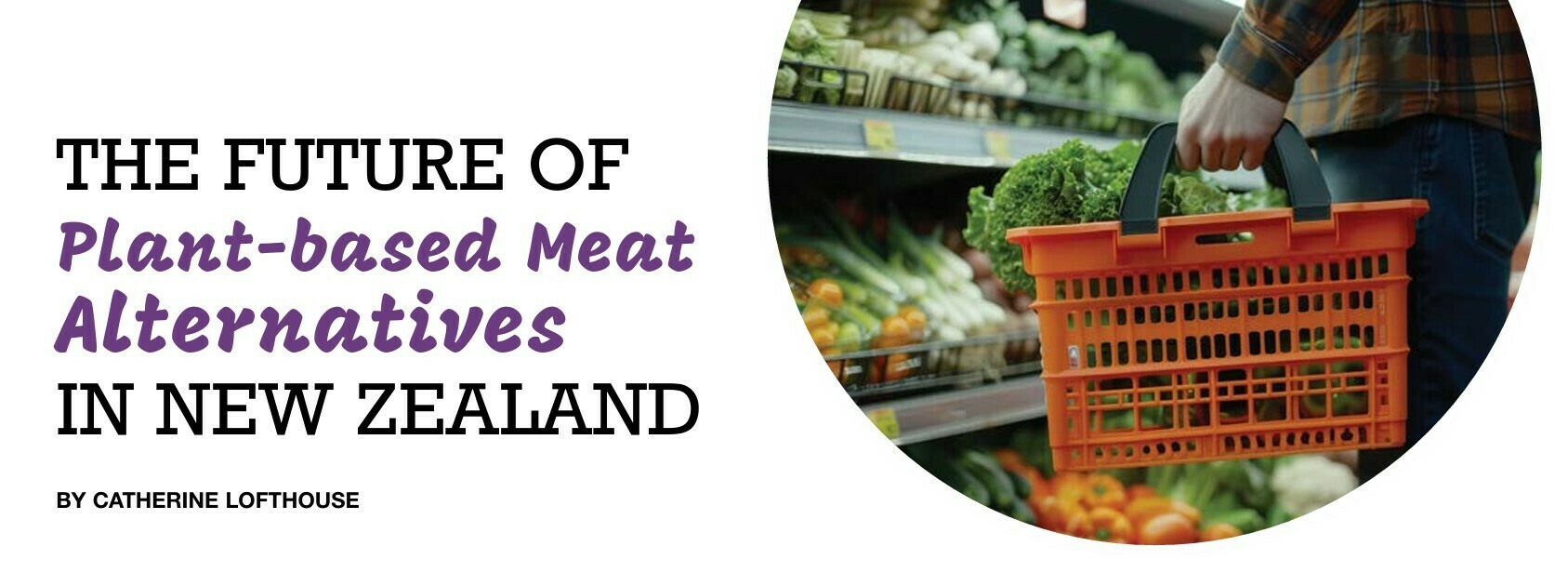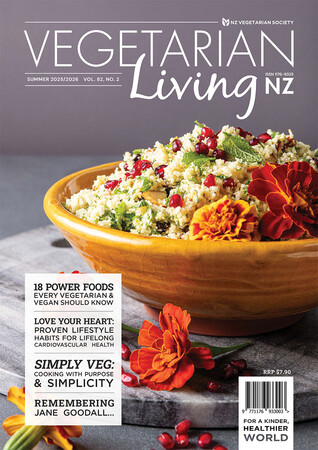
The Future of Plant-Based Meat Alternatives in New Zealand
Plant-based meat alternatives (PBMAs), such as vegetarian sausages, burgers, mince, and coated chicken provide an alternative to conventional meat products. Different to traditional non-meat substitutes like tofu, tempeh, or seitan, PBMAs are often made to represent the taste, appearance, or overall experience of eating meat products. They are a popular choice for consumers looking for a healthy, convenient, and more environmentally friendly alternative to meat products.
PBMAs have potential to play an important role in the food sector. In New Zealand, up to 5% of us identify as vegetarian, 2% vegan and 7% flexitarian (1–3). Furthermore, around half of New Zealanders surveyed last year stated they would be open to eating PBMAs (4). Despite an initial surge in popularity when PBMAs first entered the market, retail sales have since plateaued, and some smaller manufacturers are now withdrawing from the market altogether. This article looks at what is driving these shifts in the PBMA sector, and the predicted future for PBMAs in New Zealand.
Recent Changes in the PBMA Market
The last year has been difficult for small New Zealand-based PBMA manufacturers. We have seen Sunfed Meats, Food Nation, and Sustainable Foods (brand name Plan*t) all go into administration due to low retail sales and insufficient ongoing investment. The same is happening in other countries. A recent decline in PBMA retail sales has been reported worldwide, and is attributed to extreme weather conditions, supply chain disruptions caused by COVID and the war in Ukraine, unsustainable growth trajectories and the global cost-of-living crisis (5,6).
Inflation has seen many consumers changing their shopping habits due to increased food prices. In general, PBMAs are more expensive than their meat counterparts, meaning they may be viewed as luxury or occasional items (5). In addition, during the recent recession, some supermarkets have prioritised chiller space for high-volume cheaper meat products in place of PBMAs, restricting their potential retail impact.
Despite a recent downturn, the PBMA market is predicted to grow in the medium to long term (6). There are already encouraging signs of growth: some Australian brands have expanded their product range this year, and in the UK, one major supermarket has reported increased sales of PBMAs in early 2024 (5). Meanwhile, New Zealand brand Off-Piste Provisions has just launched its plant-based jerky in the USA.
Predicted Growth Areas for PBMAs
To be successful long term, PBMA manufacturers, retailers, investors and foodservices all have a role to play. Changes to the formulation, price and availability of PBMAs are predicted, plus increased investment and expansion into the foodservice sector and export market.
Healthier Products and Clean Labels
With health being the leading reason for people to purchase PBMAs, there is growing demand from consumers for products that use simpler ingredients and fewer artificial additives (6–8). PBMAs are widely categorised as ultra-processed foods. Ingredients can include plant proteins, added fats, starches, colourings, binders, flavourings and other plant derivatives, and products may be made using technologies to create the desired appearance, texture and overall eating experience. This level of processing is off-putting for health-conscious consumers who want to see ‘clean labels’ with ingredients of natural origin, and PBMA manufacturers need to respond to the call. In Europe, some manufacturers are already reformulating their PBMA products to reduce the saturated fat and to fortify them with key nutrients like vitamin B12 and iron (5).
Taste and Texture Improvements
Perceived shortfalls in taste, texture, and overall sensory experience are leading barriers for consumers to try, or to repurchase, PBMAs.
Many consumers want PBMAs that taste the same as conventional meat, and manufacturers are increasingly looking to use new ingredients and technologies to mimic the taste and eating experience of real-meat products.
While almost all consumers agree that taste is the most important factor for PBMAs, not everyone is looking for the same thing from their PBMA: flexitarians may tend to prefer products that are ‘meat-like’, and young people may be more motivated by products promoting high-protein content (7). Collectively, this suggests that improvements to taste and texture, plus good nutrition, are key for the future PBMA market (9).
Diversification of Products
Although soy and wheat continue to be the most common form of plant protein, manufacturers are increasingly looking to diversify the type of plant protein in their products to offer more choice in taste and texture and appeal more widely to consumers. In future we may see more products made from peas, broad beans, lentils and chickpeas (5).
We are also seeing changes in the type of PBMAs sold in-store. Although demand for plant-based mince, burgers and sausages has remained relatively stable, the last three years has seen an increase in other formats such as chunks, strips, deli-style meats and crumbed ‘chicken’, and a decrease in seafood-style products (5).
The past two years has also seen an increase in the number of frozen PBMAs in the market. Compared to chilled products, frozen PBMAs have the benefit of a longer shelf life and slightly lower price for the same quality of product (5).
In future, we may also see more blended or hybrid products that combine plant-based protein with animal ingredients. These potentially give consumers a healthier, more cost-effective and more sustainable product, offering them the benefits of both plant-based and animal foods (5).
Price Parity
The price of PBMAs remains one of the biggest barriers to consumers, and price reductions are needed for PBMAs to be adopted more widely. Although PBMAs are trending towards price parity with conventional meat, recent data from Australia shows that they still cost 33% more than meat products. Overall, the price of PBMAs in Australia increased by 7.4% between 2021 and 2023. This compares with an increase of 8.2% for conventional meat and seafood over the same period. Not all PBMAs were equal in this regard: plant-based bacon and burgers increased in price the most since 2021 and were the most expensive products compared to their meat counterparts. In comparison, chicken-style chunks/strips, ready meals and seafood-style products were roughly the same price as their conventional counterparts (5). On average, imported PBMAs are more expensive than products produced domestically.
Expansion into the Foodservice Sector
To date, sales of PBMAs in New Zealand have been largely retail-based. However, the foodservice sector is an emerging growth area for PBMAs. In Australia, foodservice sales have increased by 59% annually over the last three years, with fast food outlets leading the way (5). PBMAs could also expand in other foodservice outlets, including restaurants, residential facilities, education settings and hospitals.
In New Zealand, PBMAs appear on the menus of some foodservice operators but there remains scope for many more operators to broaden their menu. If the foodservice sector can fulfil this opportunity, this increases reach to wider consumer groups, normalises PBMAs as part of the standard meal offering, and increases overall consumer uptake.
Sustainable Funding
PBMA companies rely primarily on investment from private sources. This makes start-ups and smaller manufacturers especially vulnerable during times of recession because investors can cease funding. Plant-based foods are not the only sector impacted by lack of ongoing investment recently: a decline in funding has been reported across numerous industries (5). Nonetheless, ongoing investment could enable the PBMA sector to develop improved technologies and to diversify the ingredients and range of products available, with the effect of increasing consumer sales.
Exports to Asian Markets
The wider Asia Pacific region, particularly China, is predicted to bring growth opportunities for PBMA manufacturers. Over the last three years, Australian PBMA manufacturers have already increased their exports within Asia, acting on established trading links and a growing demand for alternative proteins. To be successful in the Asian market will require adapting current product offerings to meet localised tastes and formats. For example, the Asian market may need to focus on products such as strips or chunks that are more suited to Asian cuisine than burger patties (5).
Conclusion and Recommendations
- Despite an initial surge in popularity, sales of PBMAs have plateaued due to rising inflation costs, supply chain disruptions and unsustainable growth trajectories. PBMAs are predicted to grow in the medium to long term.
- In future, we may see a shift in product formulation, price, and availability of PBMAs, and expansion into the foodservice sector and export markets.
- Look for products with the ‘Vegetarian Society Approved’ or ‘Vegan Certified’ trademark for foods that are suitable for vegans or vegetarians – this includes packaged foods and some restaurant menus.
- For budget-friendly vegetarian proteins, try legumes, seitan or textured vegetable protein (TVP). Soy products (tofu, tempeh and edamame) are also good options.
- For information on how PBMAs compare to conventional meat products, see “Plant-based meat alternatives: Are they a healthy choice?” Vegetarian Living NZ, VOL. 80, NO. 1.
By Catherine Lofthouse
Catherine Lofthouse is a passionate plant-based foodie who loves to explore all things related to veg~n living. She is also a registered dietitian.
For more articles see our quarterly magazine Vegetarian Living NZ.
References
1. Greenwell J, Grant M, Young L, Mackay S, Bradbury KE. The prevalence of vegetarians, vegans and other dietary patterns that exclude some animal-source foods in a representative sample of New Zealand adults. Public Health Nutr. 2023/12/05 ed. 2024;27(1):e5.
2. Milfont TL, Satherley N, Osborne D, Wilson MS, Sibley CG. To meat, or not to meat: A longitudinal investigation of transitioning to and from plant-based diets. Appetite. 2021 Nov 1;166:105584.
3. Realini CE, Driver T, Zhang R, Guenther M, Duff S, Craigie CR, et al. Survey of New Zealand consumer attitudes to consumption of meat and meat alternatives. Meat Sci. 2023 Sep 1;203:109232.
4. Kantar. Rabobank - KiwiHarvest New Zealand Food Waste Survey 2023 Results [Internet]. Kantar; 2023 [cited 2024 Sep 23]. Available from: https://www.rabobank.co.nz/con...;
5. Kalocsay, Klara, Eassom, Simon, King, Thomasx, O’Neill, Susie, Cogo, Kathy, Redmond, Megan. State of the Industry: Australia’s plant-based meat industry. Melbourne: Food Frontier; 2024 Apr.
6. EY Parthenon. How alternative proteins are reshaping meat industries [Internet]. 2023 Mar [cited 2024 Sep 19]. Available from: https://www.ey.com/en_nz/insig...;
7. Food Navigator Europe. foodnavigator.com. 2024 [cited 2024 Sep 19]. ‘What’s in it and why?’ How ‘educated’ consumers are shaping the plant-based meat market. Available from: https://www.foodnavigator.com/...;
8. The Food Institute. The Food Institute. 2024 [cited 2024 Sep 19]. Plant-Based Meat: What’s in Store for 2024? Available from: https://foodinstitute.com/focu...;
9. Weerawarna N.R.P. M, Giezenaar C, Coetzee P, Godfrey AJR, Foster M, Hort J. Motivators and barriers to plant-based product consumption across Aotearoa New Zealand flexitarians. Food Qual Prefer. 2024 Aug 1;117:105153.




